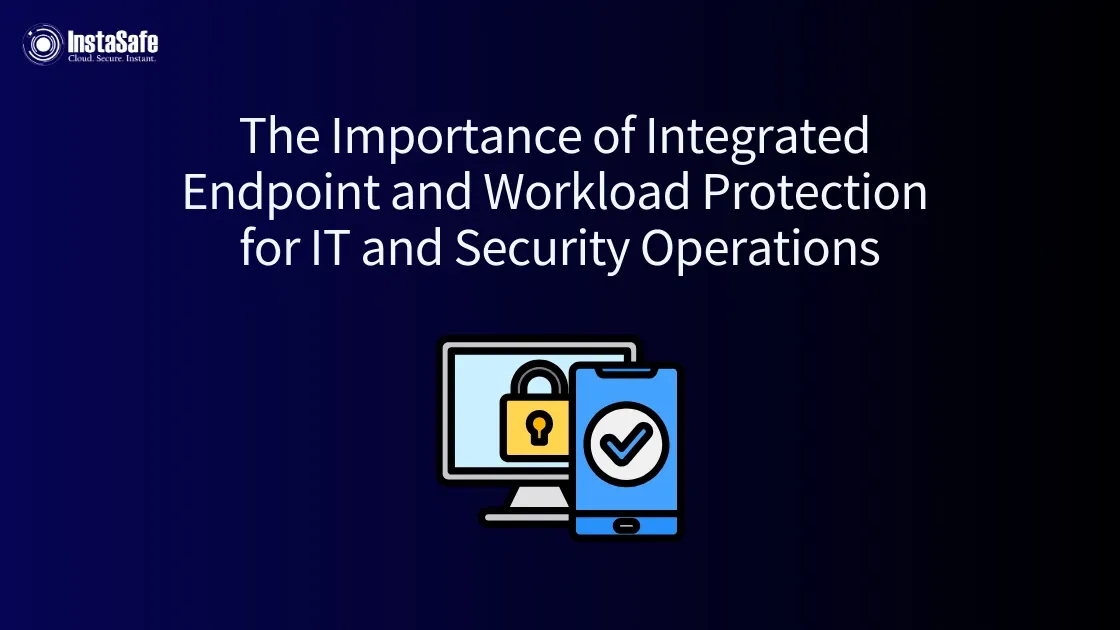The Importance of Integrated Endpoint and Workload Protection for IT and Security Operations

Companies today face relentless cyber threats targeting both endpoint security and data. Traditional approaches that protect these systems create dangerous security gaps that hackers eagerly exploit.
The integrated cyber defence brings endpoint protection and workload security together into a unified solution, providing stronger protection while simplifying management. This blog explains how integrated protection strengthens your security posture while reducing operational complexity.
Importance of Integrated Workload and Endpoint Protection
The integration of endpoint protection and workload security has become important as organisations face increasingly sophisticated attacks that target multiple areas of their technology infrastructure.
Enhanced Visibility Across All Systems
Integrated cyber defence provides comprehensive visibility across endpoints and workloads from a single management console. This way, security teams gain complete insight into security events happening simultaneously on user devices, servers and cloud resources.
This unified view eliminates blind spots that attackers often exploit. This, in turn, enables faster threat detection and more efficient IT security operations.
Streamlined Management and Policy Control
Managing security across multiple platforms becomes much easier with integrated solutions. Organisations can implement consistent security policies across all endpoints and workloads from a centralised console.
This streamlined approach reduces administrative overhead and ensures that security configurations remain consistent across the whole infrastructure. This helps in strengthening overall endpoint protection.
Improved Detection Through Shared Intelligence
When endpoint protection and workload security solutions work together, they share important threat intelligence that improves detection capabilities.
Suspicious activity observed on endpoints can inform workload protection systems. Meanwhile, threats detected in server environments can enhance endpoint security policies. This intelligence sharing creates a comprehensive security posture that adapts to emerging threats.
Faster Incident Response Times
Integrated solutions enable faster response through coordinated actions across all systems. When threats are detected, security teams can quickly contain affected endpoints and workloads. Next, they investigate the root cause and implement remediation measures using a single platform.
This speed significantly reduces the potential impact of security incidents and improves overall IT security operations efficiency.
Reduced Performance Impact
Modern integrated solutions optimise resource utilisation to minimise performance impact. Cloud-based processing offloads intensive security tasks, while intelligent scanning technologies reduce the burden on local systems.
This efficiency helps maintain system performance while providing robust endpoint protection and workload security, addressing a common complaint about traditional security tools.
Simplified Compliance Management
Organisations facing regulatory requirements benefit from the centralised reporting capabilities of integrated solutions. Security teams can quickly generate compliance reports which cover both endpoints and workloads, streamlining audit processes.
This unified approach to compliance reporting reduces the effort required to maintain regulatory standards across diverse technology environments.
Lower Total Cost of Ownership
Integrated cyber defence solutions typically offer a lower total cost of ownership compared to managing multiple standalone products. With the right solution, organisations can reduce licensing costs, minimise infrastructure requirements, decrease training expenses and improve operational efficiency.
These savings make comprehensive security more accessible for organisations with limited security budgets.
Best Practices for Integrated Cyber Defence Implementation
Zero Trust Implementation
Integrated cyber defence works best with zero trust principles. Your workload security improves when servers verify all connections, even from inside the network. Thus, IT security operations teams should deploy Zero Trust solutions to all devices. Endpoint protection becomes stronger when systems check every user and device before allowing access.
Cloud-Native Security
IT security operations need consistent security across all environments, be it traditional or cloud-based systems. Deploy cloud-based tools that protect both endpoints and workloads with the same rules. When endpoint protection and workload security work together in the cloud, companies stay safer.
Identity and Access Management Integration
Workload security gets stronger when server access links to verified identities. Hence, connect your endpoint protection with user identity systems. This helps IT security operations track who uses which device. Note that the integrated cyber defence works better when it knows both the device and the person using it.
Container and Microservices Protection
Integrated cyber defence needs to protect all parts of your network, including microservices that work together. Moreover, IT security operations must watch both traditional and modern systems. Make sure to secure small software containers the same way you protect endpoints.
Employee Training and Awareness
Integrated cyber defence depends on both technology and people working together to stop attacks. So, teach your staff about security threats to improve endpoint protection.
Users who recognise dangers help IT security operations spot problems early. Similarly, workload security improves when everyone follows good practices.
Regular Updates and Patch Management
Keep all systems updated to fix security gaps that hackers may target. For this, IT security operations should patch both endpoints and servers quickly. Integrated cyber defence gets stronger each time you update your protection tools and systems. Besides, workload security is also enhanced by running current software versions.
Centralised Monitoring
IT security operations need complete visibility across the network for smooth functioning. This is where centralised monitoring helps by detecting threats early. Both endpoint protection and workload security send alerts to one place. Integrated cyber defence works best when teams see the whole picture at once.
Automated Response Capabilities
Integrated cyber defence works faster when routine threats get instant attention. To ensure this, set up systems to fight common attacks without human help. This gives IT security operations more time for complex problems. Both endpoint protection and workload security should respond automatically.
Conclusion
As threats are evolving, the integration of endpoint protection and workload security has become essential for effective IT security operations. Organisations that implement integrated cyber defence solutions gain significant advantages in threat detection, operational efficiency and overall security posture.
Don't leave your enterprise vulnerable at its most critical access points. InstaSafe's Endpoint Security solutions deliver robust protection against sophisticated threats while maintaining efficient system performance.
Our solution prevents data loss, secures remote work, protects against breaches and ensures regulatory compliance — all from a centralised platform. Book a demo today to discover how InstaSafe transforms your security operations.
Frequently Asked Questions (FAQs)
- What are the three main steps of endpoint security?
The three main steps of endpoint security are:
- Assessment and Visibility: Identify all endpoints and vulnerabilities within your network to establish a comprehensive workload security baseline.
- Protection Implementation: Deploy integrated cyber defence solutions, including antivirus, firewall and encryption technologies.
- Continuous Monitoring: Maintain vigilance through real-time threat detection and automated response protocols.
- Why is endpoint security extremely important for an organisation?
Endpoint security is crucial because endpoints are primary attack vectors. Without it, organisations risk data breaches, operational disruption and regulatory penalties. Integrated cyber defence protects valuable business assets from increasingly sophisticated threats.
- What is the difference between endpoint protection and endpoint security?
Endpoint protection focuses specifically on defending individual devices using basic tools like antivirus. Endpoint security is broader, encompassing comprehensive workload security strategies, advanced threat hunting and integrated cyber defence across the entire network ecosystem.
